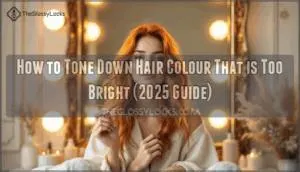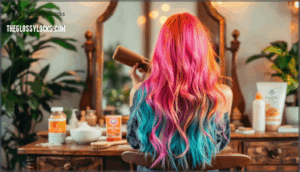This site is supported by our readers. We may earn a commission, at no cost to you, if you purchase through links.

Your hair absorbed 30% more pigment than expected because bleaching cranked your porosity levels sky-high, and now you’re stuck with a shade that screams instead of whispers.
The good news? You don’t need another round of harsh chemicals or an emergency salon visit to fix this. Simple adjustments using products already in your bathroom—plus a few strategic techniques—can bring that brightness down to a shade you’ll actually want to wear.
Table Of Contents
- Key Takeaways
- Why Does Hair Color Turn Out Too Bright?
- How to Fade Bright Hair Color Safely
- Toning Down Bright or Brassy Tones
- At-Home Remedies to Soften Vibrant Hair Color
- Salon Treatments and Professional Solutions
- Frequently Asked Questions (FAQs)
- How long does it take to tone down bright hair color?
- Is toning with gloss shampoo more effective than using a toner?
- How long does bright hair color typically last?
- Can diet or water quality affect hair brightness?
- How often should I wash overly bright hair?
- Is heat styling safe on freshly colored hair?
- Conclusion
Key Takeaways
- Hair turns out too bright mainly because bleaching increases porosity by up to 60%, causing strands to absorb 30% more pigment than expected—especially with vivid dyes that pack double the pigment concentration of natural shades.
- Clarifying shampoo applied to dry hair strips excess color safely when used every 24-48 hours, while toning products (purple for yellow, blue for orange, green for red) neutralize unwanted tones through opposing color pigments based on your specific brassiness.
- Natural remedies like chamomile tea rinses, apple cider vinegar, and honey-baking soda masks offer gentler fading alternatives that work gradually without harsh chemicals, though they require consistent weekly application for visible results.
- Professional color correction delivers immediate results through specialized formulas, lowlights for dimension, root shadowing for natural depth, and color removers that break down pigments without bleach—options unavailable in retail products.
Why Does Hair Color Turn Out Too Bright?
You’ve followed the instructions, picked the perfect shade, but somehow your hair turned out way brighter than you expected. This frustrating situation happens more often than you’d think, and it’s not always your fault.
Let’s look at the main reasons your color might’ve gone rogue so you can avoid it next time.
Common Causes of Overly Bright Hair
Your hair ended up neon-bright because bleaching cranked up porosity by up to 60%, making dye molecules grab on harder than expected. Uneven application or leaving color on too long—even 10 extra minutes—can push brightness 20% past your target.
Vivid dyes pack double the pigment concentration of natural shades, and if you’re working with damaged or porous strands, you’re looking at a 25% brightness spike right out of the gate. Understanding hair porosity effects is essential to achieving the desired hair color.
Effects of Hair Porosity and Previous Color
Once porosity goes haywire from past bleach jobs or repeated dyeing, your strands become color-grabbing magnets—or stubborn walls. Here’s what you’re up against:
- High porosity hair absorbs dye up to 30% faster, yanking you two shades darker than planned
- Bleached hair shows porosity levels four times higher than virgin strands, causing uneven saturation
- Old dye residues create patchy absorption zones with 10–15% tonal variance from roots to ends
- Low porosity hair resists color absorption, leaving you with weak, muted results no matter how long you wait
Previous color treatments wreck your hair’s ability to retain pigment evenly. Fading prevention starts with understanding these porosity patterns—protein masks and acidic conditioners tighten cuticles and stabilize hair color correction before your next toning attempt. To address these issues, consider learning about hair porosity issues to better understand how to care for your hair.
How Different Shades React to Dye
Your starting shade sets the stage—blonde hair snaps up cool tones while brown hair drinks in warm pigments, and that color chemistry dictates whether you’ll land on chic or clash.
Darker hair pigmentation resists dye penetration, creating tint resistance that blocks lighter shades entirely. Meanwhile, bleached strands with zero melanin absorb everything—causing shade variation and extreme color depth analysis problems.
Red dyes intensify on warm bases, while ash tones vanish without proper hair toning techniques and color neutralization.
How to Fade Bright Hair Color Safely
When bright hair color goes wrong, you don’t have to panic or reach for harsh chemicals right away. The key is fading the intensity gradually while keeping your hair healthy and intact.
Here’s how to strip excess color safely without turning your strands into straw.
Using Clarifying Shampoo to Strip Excess Color
Think of clarifying shampoo as the reset button your hair desperately needs—it works by opening the hair cuticle and washing away layers of built-up pigment that make your color look too intense.
The secret lies in using a sulfate-based formula, which acts more aggressively than regular shampoo for effective color correction.
Apply it directly to dry hair before wetting—this maximizes sulfate effects on hair porosity and helps with color neutralization where you need it most.
Repeating The Process for Gradual Fading
Patience becomes your best friend here—rushing through multiple washes in one day will leave your hair fried and your scalp screaming for mercy.
Space your clarifying sessions every 24-48 hours to allow gradual fading without compromising your hair’s integrity. This gentle stripping approach gives you control over color correction while protecting your strands.
Your fading frequency game plan:
- Day 1-3: Expect subtle shifts—your hair needs time to release pigment gradually
- Day 4-7: Watch the transformation accelerate as toning techniques take effect
- Week 2+: Assess whether you’ve hit your target or need another round of hair color fading
Avoiding Hair Damage During Fading
Stripping color aggressively might fade your hair fast, but it’ll torch your strands like a forgotten curling iron if you’re not careful. Between each clarifying session, deep condition religiously to maintain moisture and prevent breakage.
Your damage repair strategy should include protein treatments and gentle fading methods that prioritize color protection alongside hair toning—because healthy hair holds color better anyway.
Toning Down Bright or Brassy Tones
Once you’ve faded your too-bright color, toning is your next move to neutralize unwanted warmth or brassiness. The right toning product works by depositing opposing color pigments that cancel out those fiery or brassy undertones.
Let’s break down how to choose and use toning shampoos, glosses, and color correctors to get your hair back on track.
Choosing The Right Toning Shampoo (Purple, Blue, Green)
Toning shampoo works like a color correction filter for your hair—purple neutralizes yellow in blondes, blue counteracts orange in brunettes, and green cancels red undertones in darker shades.
Your hair porosity affects how quickly toner ingredients absorb, so porous hair needs less frequent applications. Start with once-weekly use to avoid pigment buildup, adjusting based on your specific brassiness level and shade.
Applying Toning Products for Optimal Results
To get salon-quality results, you’ll need to apply your toning product to damp—not soaking wet—hair, working it through evenly from roots to ends like you’re coating every strand with intention.
Here’s how to nail your toner application methods:
- Section your hair into four quadrants for even coverage
- Time precisely—leave purple shampoo on 3-5 minutes, adjusting for hair porosity treatment needs
- Emulsify with water halfway through to activate color correction techniques
- Focus on brassy zones like your crown when toning down blonde hair
- Rinse with cool water to seal the cuticle and lock in fixing brassy hair results
Using Glosses and Color Correctors
When toning shampoo isn’t cutting it, glosses and color correctors work like a precision filter—they neutralize stubborn brightness and seal in the exact shade you’re after. Glosses coat each strand with pigment removal power, while toner formulas target specific undertones through sophisticated color correction techniques.
For shade adjustment on blonde hair, a demi-permanent hair gloss delivers color toning without harsh chemicals, making hair color correction feel more like a treatment than a fix.
At-Home Remedies to Soften Vibrant Hair Color
If chemicals aren’t your thing, your kitchen might contain the answer. Natural remedies work slower than harsh treatments, but they’re gentler on your hair and won’t strip it completely.
Here’s what actually works when you want to soften that color without another trip to the salon.
Chamomile Tea Rinse for Subtle Toning
If you’ve ever wished for a gentler way to soften overly bright blonde or brassy tones without reaching for harsh chemicals, chamomile tea might become your new go-to remedy. This herbal hair care method works gradually, offering natural toning through gentle fading rather than aggressive hair dye correction.
Brew strong chamomile tea, let it cool, and pour it over your hair as a final rinse after shampooing. For subtle color correction, repeat this tea rinse treatment regularly—it won’t dramatically shift your shade overnight, but you’ll notice softer, more balanced tones that feel less jarring than typical toning shampoo results.
Apple Cider Vinegar for Reducing Brassiness
Apple cider vinegar does double duty—it balances your hair’s pH while helping neutralize unwanted warm tones that refuse to fade on their own.
Mix one part apple cider vinegar with two parts water, pour it through your hair after shampooing, and let it sit for a few minutes before rinsing.
This natural toner offers a gentle brassiness fix without the commitment of purple shampoo or aggressive color correction methods.
Honey and Baking Soda Masks for Fading Color
Honey and baking soda work like a one-two punch—honey gradually lightens overly vibrant color while moisturizing, and baking soda lifts away stubborn pigment without the harsh chemicals found in commercial removers.
Here’s how to use these DIY color correction remedies:
- Honey mask: Mix raw honey with your conditioner, apply to damp hair, and leave for an hour before rinsing.
- Baking soda paste: Combine baking soda with water, gently massage into problem areas, and rinse after a few minutes.
- Combined treatment: Alternate between both methods weekly for gradual, natural hair dye removal results.
Salon Treatments and Professional Solutions
Sometimes at-home fixes can only take you so far, and that’s when a professional’s expertise becomes essential. Colorists have specialized techniques and products that can correct even the most stubborn color issues without wrecking your hair.
Here’s what you can expect when you book a salon appointment for color correction.
Adding Lowlights or Root Shadows
Lowlights work like shadows for your hair, breaking up that all-over brightness and adding depth that makes the color look less jarring and more natural. Your colorist can weave in darker strands using the lowlights technique, creating hair dimension that mimics how sunlight would naturally play across your strands.
Root shadowing takes this further by darkening your base, giving you color depth that grows out seamlessly—no harsh lines, just natural layers that let you breathe easy between appointments.
Professional Color Correction Services
Sometimes lowlights aren’t enough—you need a full reset. Professional color correction services bring expert advice and salon techniques that home remedies can’t match. Your colorist uses specialized formulas for hair restoration, mixing custom toners and applying strategic color toning to neutralize brightness while protecting your strands.
Here’s what professional hair color correction offers:
- Color correction formulas unavailable in retail products
- Professional consultation to assess damage and porosity
- Tailored hair color maintenance plans for long-term results
These salon services give you back control without guessing games or further damage.
Using Hair Color Removers Safely
Hair color removers sound intimidating, but they’re your safety net when toning alone won’t cut it. These gentle formulas break down artificial pigments for effective color removal without bleach’s harsh bite.
Choose remover strengths based on your color intensity—mild for subtle corrections, stronger for dramatic hair dye removal. Following safe application instructions prevents hair damage while achieving color neutralization.
It’s liberation in a bottle when you need serious hair color correction.
Frequently Asked Questions (FAQs)
How long does it take to tone down bright hair color?
Wondering how quickly you can escape that neon nightmare? Color Fading Time depends on your method—toning shampoo works within days, while natural remedies like chamomile need weeks.
Professional Color Correction delivers instant Brightness Reduction, but gradual Hair Recovery through Purple Shampoo and clarifying treatments usually shows results in one to two weeks.
Is toning with gloss shampoo more effective than using a toner?
Toning shampoo offers gradual color correction with each wash, while a dedicated gloss treatment delivers more dramatic, immediate results.
Your choice depends on whether you want subtle maintenance or bold transformation—both excel at different toning goals.
How long does bright hair color typically last?
Like a fireworks show that fizzles fast, bright hair color usually lasts two to four weeks before the vibrant tone longevity starts declining.
Hair color fading accelerates with washing—your color fade rate depends on porosity and how well you maintain it using toning shampoo between touch-ups.
Can diet or water quality affect hair brightness?
Yes, both play a role. Water Hardness from mineral buildup can make hair color appear duller or shift tones over time. Environmental Factors and Mineral Impact affect how your hair holds pigment, influencing Hair Color Fading and overall Hair Damage Prevention.
Dietary Changes that support Hair Nutrition—like protein and vitamins—strengthen strands and help maintain vibrancy.
How often should I wash overly bright hair?
To preserve your color and maintain hair moisture balance, you’ll want to wash less often—every 2-3 days max.
Use a hydrating shampoo or purple shampoo sparingly, as overwashing strips pigment faster and disrupts your hair care routine.
Is heat styling safe on freshly colored hair?
Strike while the iron’s cold—heat styling fresh hair color invites heat damage and accelerated color fading.
Wait 48-72 hours before using styling tools, and always apply a thermal protectant to create a barrier that shields your color protection investment from high thermal limits.
Conclusion
Think of your hair like an oversteeped tea bag—it absorbed more color than intended, but the fix isn’t starting over. You’ve now got multiple proven methods to tone down hair colour that’s too bright without another salon appointment or harsh chemical reset.
Whether you fade gradually with clarifying shampoo, neutralize unwanted tones with purple or blue formulas, or book a professional color correction, you control the outcome.
Your hair doesn’t need rescuing—it needs the right adjustment, and you just learned exactly how to deliver it.
- https://www.instagram.com/colorbymattrez/?hl=en
- https://www.sallybeauty.com/just-ask-sally/articles/10-things-you-need-to-know-before-you-get-vivid-hair/
- https://theshade.com.au/how-hair-porosity-affects-hair-colour/
- https://www.wecolour.com/en/help/faq/after-colouring/my-hair-colour-has-become-too-bright/
- https://pmc.ncbi.nlm.nih.gov/articles/PMC3927172/









